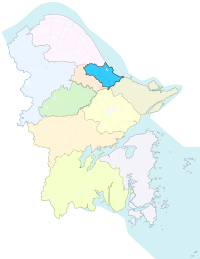Zhenhai District
Zhenhai[lower-alpha 1] is a district and former county of the prefecture-level city of Ningbo in Zhejiang Province in eastern China. It has a population of 200,000.
History
The town of Zhenhai grew up at the foot of Zhaobao Hill on a tongue of land at the mouth of the Yong River about 12 miles (19 km) north-east of central Ningbo.[1]
Under the Qing, the city walls covered a circuit of 3 miles (5 km) and rose to 20 feet (6 m).[1] The British captured Zhenhai on 10 October 1841 during the First Opium War, dismantling its former citadel. The Zhenhai Coastal Battery was the site of the 1885 Battle of Zhenhai during the Sino-French War.[3]
In the later 19th century, Zhenhai was protected from the sea by a dike about 3 miles (4.8 km) long, made of large blocks of hewn granite.[1]
Zhenhai has suffered severe long-term air pollution mainly emanating from the Ningbo Petro-Chemical Economic and Technical Development Zone built on its eastern coast. The zone is home to nearly 200 chemical plants including Zhenhai Refining and Chemical Corporation (ZRCC),a subsidiary of Sinopec and the largest oil refinery in China, LG-Yongxing, the largest ABS plastic producer in China and Zhenhai Port Liquid Chemical Dock, the largest liquid chemical dock in China. In September, 2007, 400 tones of acrylonitrile leaked from the LG-Yongxing plant and polluted air and underground water around adjacent areas.[4][5] In late April, 2012, three million bees died in an orchard in Xiepu Town next to the Petro-Chemical Zone because of pollutants discharged by a chemical plant.[6] Research has shown that the ratio of deaths from cancer in Zhenhai rose significantly between 2007 and 2009.[7]
From May 16 to 17, 2002, residents in Zhenhai launched protests against environmental degradation caused by the chemical industry, blocking the district's traffic on its main streets.[8] In October, 2012, angry people staged demonstrations against a giant petro-chemical project scheduled by ZRCC and clashed with police. The 50 billion yuan ($8 billion) integrated investment project, according to some reports, will affect more than 9800 households. Many argue that the environment in Zhenhai has been tremendously overloaded and the new project will bring even more harm to the ecosystem.[9]
Notable individuals
| Wikimedia Commons has media related to Zhenhai. |
Notes
- 1 2 3 4 5 EB (1878).
- 1 2 EB (1911).
- ↑ Decennial Reports on the Trade Navigation Industries, Etc., of the Ports Open to Foreign Commerce in China and Corea, and on the Conditions and Development of the Treaty Port Provinces China. 1893. p. 346
- ↑ "Zhenhai successfully deal with a chemical leak accident (镇海妥善处置一起化学品泄漏事故)" (in Chinese). Ningbo Daily. 2007-10-09. Retrieved 2012-10-26.
- ↑ "Advanced techniques for water pollution prevention (水污染治理先进技术汇编)". Ministry of Science and Technology of the People's Republic of China. August 2011. pp. 167–168. Retrieved 2012-10-26.
- ↑ "3 million bees died without evidences, reasons and remains to be investigated (300萬隻蜜蜂離奇集體死亡 死因待查)" (in Chinese). Apple Daily. 2012-05-06. Retrieved 2012-05-07.
- ↑ Qingwei Yang; Zijun Feng; Jiaan Fang (March 2011). "Malignant tumor mortality and reduction of life span in Zhenhai District of Ningbo during 2007~2009". Chinese Rural Health Service Administration.
- ↑ "Big events in Zhenhai, 2002 (镇海区2002年大事记)" (in Chinese). Zhenhai Archive. 2007-10-10. Retrieved 2012-10-26.
- ↑ E China city defends chemical plant after protests
References
-
 Baynes, T.S., ed. (1878), "Chin-hae", Encyclopædia Britannica, 5 (9th ed.), New York: Charles Scribner's Sons, p. 674.
Baynes, T.S., ed. (1878), "Chin-hae", Encyclopædia Britannica, 5 (9th ed.), New York: Charles Scribner's Sons, p. 674. -
 Chisholm, Hugh, ed. (1911), "Chên-hai", Encyclopædia Britannica, 6 (11th ed.), Cambridge University Press, p. 78.
Chisholm, Hugh, ed. (1911), "Chên-hai", Encyclopædia Britannica, 6 (11th ed.), Cambridge University Press, p. 78.
Coordinates: 29°58′N 121°43′E / 29.96°N 121.72°E


